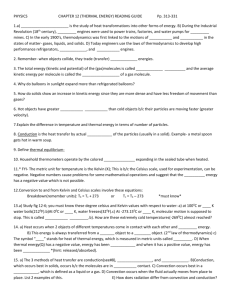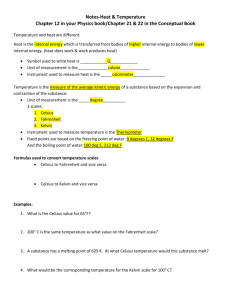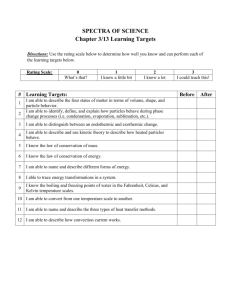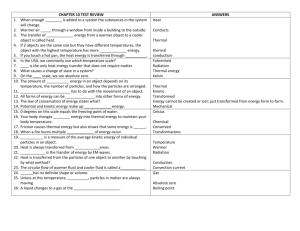Chapter 1
advertisement
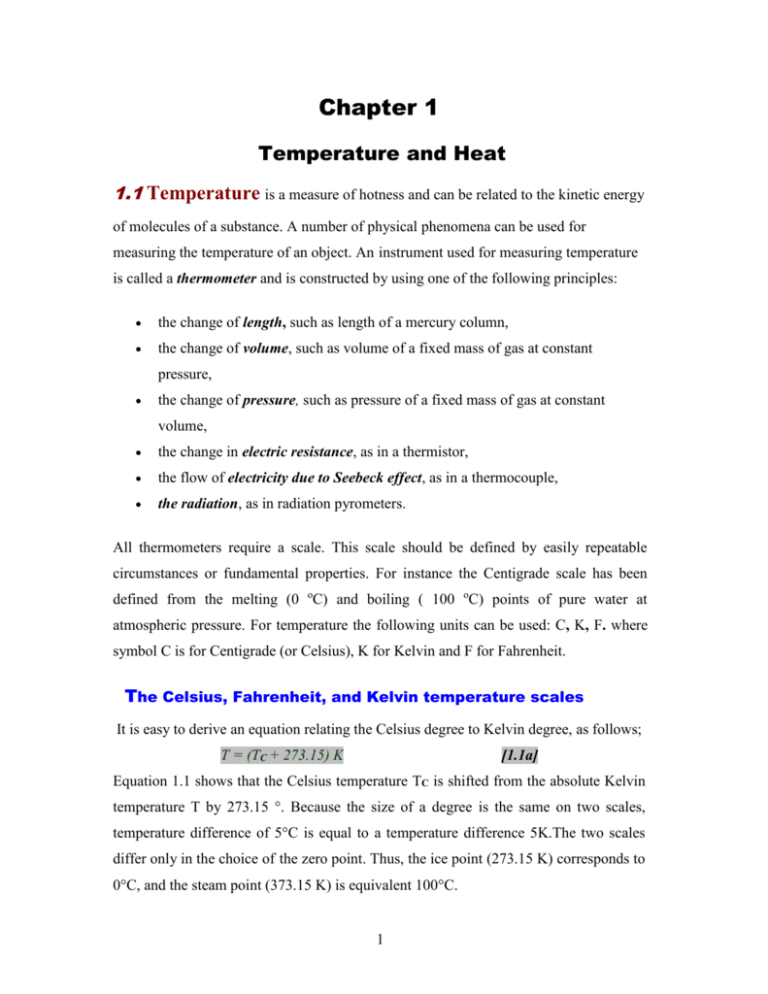
Chapter 1 Temperature and Heat 1.1 Temperature is a measure of hotness and can be related to the kinetic energy of molecules of a substance. A number of physical phenomena can be used for measuring the temperature of an object. An instrument used for measuring temperature is called a thermometer and is constructed by using one of the following principles: the change of length, such as length of a mercury column, the change of volume, such as volume of a fixed mass of gas at constant pressure, the change of pressure, such as pressure of a fixed mass of gas at constant volume, the change in electric resistance, as in a thermistor, the flow of electricity due to Seebeck effect, as in a thermocouple, the radiation, as in radiation pyrometers. All thermometers require a scale. This scale should be defined by easily repeatable circumstances or fundamental properties. For instance the Centigrade scale has been defined from the melting (0 oC) and boiling ( 100 oC) points of pure water at atmospheric pressure. For temperature the following units can be used: C, K, F. where symbol C is for Centigrade (or Celsius), K for Kelvin and F for Fahrenheit. The Celsius, Fahrenheit, and Kelvin temperature scales It is easy to derive an equation relating the Celsius degree to Kelvin degree, as follows; T = (TC + 273.15) K. [1.1a] Equation 1.1 shows that the Celsius temperature TC is shifted from the absolute Kelvin temperature T by 273.15 °. Because the size of a degree is the same on two scales, temperature difference of 5°C is equal to a temperature difference 5K.The two scales differ only in the choice of the zero point. Thus, the ice point (273.15 K) corresponds to 0°C, and the steam point (373.15 K) is equivalent 100°C. 1 The most common temperature scale in everyday use in the United States is Fahrenheit scale. This scale sets the temperature of the ice point at 32°F and temperature of the steam point at 212°F. The relationship between the Celsius and Fahrenheit temperature scales is TF = (9/5) TC +32 oF [1.2b] Equation 1-2 can be used to find a relationship between changes in temperature on the Celsius and Fahrenheit scales. ∆ TC =∆T=(5/9) ∆TF [1.2c] Where as the change in temperature on the Celsius scale equals the change on Kelvin scale. That is; ∆T = ∆ TC . Figure 1.1 Comparison between temperature scales EXAMPLE 1.1 On a day when the temperature reaches 50°F, what is the temperature in degrees Celsius and in Kelvin? Solution Substituting TF = 50°F into Equation 1.2, we get Tc = (5/9)(TF - 32) =(5/9) (50 - 32) = 10°C From Equation 1.1, we find that T=Tc+ 273.15 = 283.15 K EXAMPLE 1.2 A pan of water is heated from 25°C to 80°e. What is the change in its temperature on the Kelvin scale and on the Fahrenheit scale? 2 Solution from Equation 1.1, we see that the change in temperature on the Celsius scale equals the change on the Kelvin scale. Therefore, ∆T = ∆Tc = 80 – 25 =55 oC = 55 K From Equation 1.3, we find ∆TF= (9/5) ∆Tc = (9/5)(80 – 25) = 99°F EXAMPLE 1.3 The temperature gradient between the skin and the air is regulated by cutaneous (skin) blood flow. If the cutaneous blood vessels are constricted, the skin temperature and the temperature of the environment will be about the same. When the vessels are dilated, more blood is brought to the surface. Suppose that during dilation the skin warms from 72.0oF to 84.0oF. (a) Convert these temperatures to Celsius and find the difference. (b) Convert the temperatures to Kelvin, again finding the difference. Solution (a) Convert the temperatures from Fahrenheit to Celsius and find the difference. Convert the lower temperature. Convert the upper temperature Find the difference of the two temperatures (b) Convert the temperatures from Fahrenheit to Kelvin and find their difference. Convert the temperatures, using the previous answers T1=22+273.15=295.15 K T1=29+273.15=303.15 K T=303.15-295.15=7 K Remark: The change in temperature in Kelvin and Celsius is the same, as it should be. Exercise 1.1 Core body temperature can rise from 98.6F to 107oF during extreme exercise, such as a marathon run. Such elevated temperatures can also be caused by viral or bacterial infections or tumors and are dangerous if sustained. 3 (a) Convert the given temperatures to Celsius and find the difference. (b) Convert the temperatures to Kelvin, again finding the difference. Answer (a) 37.0_C, 41.7_C, 4.7_C (b) 310.2 K, 314.9 K, 4.7 1.2 Temperature and the Zeroth Law of Thermodynamics Scientists have developed a variety of thermometers for making such quantitative measurements. In order to understand the concept of temperature, it is useful to first define two often-used phrases, thermal contact and thermal equilibrium. To understand the meaning of thermal contact, imagine two objects placed in an insulated container so that they interact with each other but not with the rest of the world. If the objects are at different temperatures, energy is exchanged between them. The energy exchanged between objects because of a temperature difference is called heat. For purposes of the current discussion, we shall assume that two objects are in thermal contact with each other if heat can be exchanged between them. Thermal equilibrium is a situation in which two objects in thermal contact with each other cease to have any exchange of heat. Now consider two objects, A and C, which are not in thermal contact and a third object, B, which is our thermometer. We wish to determine whether or not A and C are in thermal equilibrium with each other. The thermometer (object B) is first placed in thermal contact with A until thermal equilibrium is reached. From that moment on, the thermometer's reading remains constant, and we record it. The thermometer is then removed from A and placed in thermal contact with C, and its reading is recorded after thermal equilibrium is reached. If the two readings are the same, then A and C are in thermal equilibrium with each other, [Fig 1.2]. [Figure 1.2] The zeroth law of thermodynamics. (a) and (b): If the temperatures of A and B are found to be the same as measured by object C (a thermometer), no energy will be exchanged 4 1.3 Thermal Expansion of Solids and Liquids Figure 2-1 The change of mercury volume with temperature Crystal structure of NaCl At ordinary temperatures, the atoms vibrate about their equilibrium positions with amplitude of approximately 10-11 and a frequency of 1013 Hz. The average spacing between the atoms is approximately 10-10 m. As the temperature of the solid increases, the atoms vibrate with larger amplitudes and the average separation between them increases. Consequently, the solid expands. If the thermal expansion of an object is sufficiently small compared with its initial dimensions, then the change in any dimension is, to a first approximation, dependent on the first power of the temperature change. This phenomenon, known as thermal expansion. Ordinarily a substance expands when heated. If an object has an initial length L0 at some temperature and undergoes a change in temperature T, its linear dimension changes by the amount L, which is proportional to the object’s initial length and the temperature change: ]1.3a] The parameter α is called the coefficient of linear expansion. The change in area of a substance with change in temperature is given by . where γ = 2α is the coefficient of area expansion. 5 [1.3b] Similarly, the change in volume with temperature of most substances is proportional to the initial volume V0 and the temperature change ∆T; [1.3c] where β=3αis the coefficient of volume expansion. The expansion and contraction of material due to changes in temperature creates stresses and strains, sometimes sufficient to cause fracturing. For isotropic materials: the coefficient of linear expansion, α, is the same in all directions. EXAMPLE 1.4 Global Warming and Coastal Flooding Goal Apply the volume expansion equation together with linear expansion. Problem (a) Estimate the fractional change in the volume of Earth’s oceans due to an average temperature change of 1C. (b) Use the fact that the average depth of the ocean is 4.00 x 103 m to estimate the change in depth. Strategy In part (a), solve the volume expansion expression, Equation 10.6, for ∆V/V. For part (b), use linear expansion to estimate the increase in depth. Neglect the expansion of landmasses, which would reduce the rise in sea level only slightly. Solution (a) Find the fractional change in volume. Divide the volume expansion equation by V0 and substitute: (b) Find the approximate increase in depth. Use the linear expansion equation. Divide the volume expansion coefficient of water by three to get the equivalent linear expansion coefficient : Remarks Three-tenths of a meter may not seem significant, but combined with increased melting of the polar ice caps, some coastal areas could experience flooding. An increase of several degrees increases the value of ∆L several times and could significantly reduce the value of waterfront property. 1.4 Thermal Expansion of Gases The properties of gases are important in a number of thermodynamic processes. Our weather is a good example of the types of processes that depend on the behavior of gas. The equation of state can be very complicated, but is found experimentally to be relatively simple if the gas is maintained at a low pressure (or a low density). Such a 6 low-density gas approximates what is called an ideal gas. Most gases at room temperature and atmospheric pressure behave approximately as ideal gases. An ideal gas is a collection of atoms or molecules that move randomly and exert no longrange forces on each other. Each particle of the ideal gas is individually pointlike, occupying a negligible volume. To illustrate the thermal expansion in gases, one considers a microscopic model of an ideal gas to simplify the topic. The model shows that the pressure that a gas exerts on the walls of its container is a consequence of the collisions of the gas molecules with the walls. Avogadro’s number is NA = 6.02 x 1023 particles/mol. A mole of anything, by definition, consists of an Avogadro’s number of particles. The number is defined so that one mole of carbon-12 atoms has a mass of exactly 12 g. The mass of one mole of a pure substance in grams is the same, numerically, as that substance’s atomic (or molecular) mass. An ideal gas obeys the equation [1.4] where P is the pressure of the gas, V is its volume, n is the number of moles of gas, R is the universal gas constant (8.31 J/mol K), and T is the absolute temperature in kelvins. A real gas at very low pressures behaves approximately as an ideal gas. Solving problems usually entails comparing two different states of the same system of gas, dividing the ideal gas equation for the final state by the ideal gas equation for the initial state, canceling factors that don’t change and solving for the unknown quantity. EXAMPLE 1.5 An Expanding Gas Goal Use the ideal gas law to analyze a system of gas. Problem An ideal gas at 20.0C and a pressure of 1.50 x 105 Pa is in a container having a volume of 1.00 L. (a) Determine the number of moles of gas in the container. (b) The gas pushes against a piston, expanding to twice its original volume, while the pressure falls to atmospheric pressure. Find the final temperature. Strategy (a) Solve the ideal gas equation of state for the number of moles, n, and substitute the known quantities. Be sure to convert the temperature from Celsius to Kelvin! (b) When comparing two states of a gas, it’s often most convenient to divide the ideal gas equation of the final state by the equation of the initial state. Then quantities that don’t change can immediately be cancelled, simplifying the algebra. 7 Solution (a) Find the number of moles of gas. Convert the temperature to kelvins: Solve the ideal gas law for n and substitute: (b) Find the temperature after the gas expands to 2.00 L. Divide the ideal gas law for the final state by the ideal gas law for the initial state: Cancel the number of moles n and the gas constant R,and solve for Tf Remark Remember the trick used in part (b), it’s often useful in ideal gas problems. Notice that it wasn’t necessary to convert units from liters to cubic meters, since the units were going to cancel anyway. Exercise 1.2 Suppose the temperature of 4.50 L of ideal gas drops from 375 K to 275 K. (a) If the volume remains constant and the initial pressure is atmospheric pressure, find the final pressure. (b) Find the number of moles of gas. Answer (a) 7.41 x 104 Pa (b) 0.146 mol 1.5 The Kinetic Theory of Gases Under the conditions of the ideal gas molecules, the equation of pressure, P, of N molecules contained in a volume V is given by as a function of kinetic energy as follows [1.5a] Where is the average kinetic energy per molecule. Comparing this equation with the equation of state for an ideal gas in the form of the equation, PV = NkBT, 8 we note that the left-hand sides of the two equations are identical. Equating the righthand sides, we obtain The quantity kB is Boltzmann’s constant (1.38 x10-23 J/K). This means that the temperature of a gas is a direct measure of the average molecular kinetic energy of the gas. As the temperature of a gas increases, the molecules move with higher average kinetic energy. The internal energy of n moles of a monatomic ideal gas is [1.5c] The root-mean-square (rms) speed of the molecules of a gas is [1.5d] 1.6 Heat and Internal Energy Internal energy is associated with a system’s microscopic components. Internal energy includes the kinetic energy of translation, rotation, and vibration of molecules, as well as potential energy. Heat is the transfer of energy across the boundary of a system resulting from a temperature difference between the system and its surroundings. The symbol Q represents the amount of energy transferred. Historically, the calorie was the unit used for heat. One calorie is the amount of energy transfer necessary to raise the temperature of 1 g of water from 14.5oC to 15.5oC. The “Calorie” used for food is actually 1 kilocalorie In the US Customary system, the unit is a BTU (British thermal unit). One BTU is the amount of energy transfer necessary to raise the temperature of 1 lb of water from 63oF to 64oF. The standard in the text is to use Joules. The standard in the text is to use Joules. 1 cal = 4.186 J this is known as the mechanical equivalent of heat. 1.7 Specific heat The energy required to change the temperature of a substance of mass m by an amount ∆T is [1.6a] where c is the specific heat of the substance. In calorimetry problems, the specific heat of a substance can be determined by placing it in water of known temperature, isolating the system, and measuring the temperature at equilibrium. The sum of all energy gains and losses for all the objects in an isolated system is given by 9 [1.6b] where Qk is the energy change in the kth object in the system. This equation can be solved for the unknown specific heat, or used to determine an equilibrium temperature. 1.8 Latent Heat and Phase Change The energy required to change the phase of a pure substance of mass m is [1.7] where L is the latent heat of the substance. The latent heat of fusion, Lf , describes an energy transfer during a change from a solid phase to a liquid phase (or vice-versa), while the latent heat of vaporizaion, Lv, describes an energy transfer during a change from a liquid phase to a gaseous phase (or vice-versa). Calorimetry problems involving phase changes are handled with Equation 1.7, with latent heat terms added to the specific heat terms 1.9 Energy Transfer Energy can be transferred by several different processes, including work and by conduction, convection, and radiation. Conduction can be viewed as an exchange of kinetic energy between colliding molecules or electrons. The rate at which energy transfers by conduction through a slab of area A and thickness L is [1.8a] where k is the thermal conductivity of the material making up the slab. Some useful conductivities are given in the following table: substance conductivity air (0 C) .000057 cal cm / s cm 2 K H 2 O (20 C) .0014 cal cm / s cm 2 K Cu .99 cal cm / s cm 2 K tissue 18 kcal cm / m 2 hr K fur/down .36 kcal cm / m 2 hr K Convection is the movement of heat by currents in the medium, i.e., the wind. The convection current in Watts is (empirically) 10 Q / t = 14.5 A Sqrt (v) T . [1.8b] when A is measured in square meters and v is the (wind) speed in m / s. Still air actually has a convection velocity of .23 m / s (called "natural convection") because warm air rises. Radiation is the emission of electromagnetic energy (which your body does in the infrared wavelengths). The radiation current (in Watts) is Q / t = A (Tb 4 - Ta 4) [1.8c] where is the "emissivity" (a dimensionless radiation "effectiveness", which is .97 for human skin independent of color, under equilibrium conditions), is the "StefanBoltzmann" constant (5.67 x 10 - 8 W / m 2 K 4) and the temperature MUST be in K (due to the fourth power dependence; "b" denotes body, while "a" denotes "ambient", or air, temperature). 1.10 Work in Thermodynamic Processes The work done on a gas at a constant pressure is [1.9] The work done on the gas is positive if the gas is compressed (∆V is negative) and negative if the gas expands (∆V is positive). In general, the work done on a gas that takes it from some initial state to some final state is the negative of the area under the curve on a PV diagram. 1.11 The First Law of Thermodynamics According to the first law of thermodynamics, when a system undergoes a change from one state to another, the change in its internal energy ∆U is [1.10a] where Q is the energy transferred into the system by heat and W is the work done on the system. Q is positive when energy enters the system by heat and negative when the system loses energy. W is positive when work is done on the system (for example, by compression) and negative when the system does positive work on its environment. 11 The energetic of the body. Conservation of energy is implicit in all our calculations of energy balance in living systems. Consider, for example, the energetic for the functioning of an animal. The body of an animal contains internal thermal energy Et, which is the product of the mass and specific heat, and chemical energy Ec stored in the tissue of the body. In terms of energy, the activities of an animal consist of simply eating, working, and rejecting excess heat by means of various cooling mechanisms (radiation, convection, etc.). Without going into detailed calculations, the first law allows us to draw some conclusions about the energetic of the animal. For example, if the internal temperature and the weight of the animal are to remain constant (i.e., Ec and Et constant), over a given period of time the energy intake must be exactly equal to the sum of the work done and the heat lost by the body. An imbalance between intake and output energy implies a change in the sum Ec +Et. 1.12 Applications 1.12.a Human metabolism Metabolism is the set of chemical reactions that happen in living organisms to maintain life. These processes allow organisms to grow and reproduce, maintain their structures, and respond to their environments. The chemical energy used by animals is obtained from the oxidation of food molecules. The glucose sugar molecule, for example, is oxidized as follows: C6H12O6 +6O2 →6CO2 +6H2O+energy For every gram of glucose ingested by the body, 3.81 Cal of energy is released for metabolic use. Animals do work and give off energy by heat and this lead us to believe the first law of thermodynamics can be applied to living organisms to describe them in a general way. 12 The internal energy stored in humans goes into other forms needed for maintaining and repairing the major body organs and is transferred out of the body by work as a person walks or lifts a heavy object, and by heat when the body is warmer than its surroundings. Because the rates of change of internal energy, energy loss by heat, and energy loss by work vary widely with the intensity and duration of human activity, it’s best to measure the time rates of change of ∆U, Q, and W. Rewriting the first law, these time rates of change are related by [1.12a] On average, energy Q flows out of the body, and work is done by the body on its surroundings, so both Q/∆t and W/∆t are negative. This means that ∆U/∆t would be negative and the internal energy and body temperature would decrease with time if a human were a closed system with no way of ingesting matter or replenishing internal energy stores. Because all animals are actually open systems, they acquire internal energy (chemical potential energy) by eating and breathing, so their internal energy and temperature are kept constant. Overall, the energy from the oxidation of food ultimately supplies the work done by the body and energy lost from the body by heat, and this is the interpretation we give the last equation. That is, ∆U/∆t is the rate at which internal energy is added to our bodies by food, and this term just balances the rate of energy loss by heat, Q/∆t, and by work, W/∆t. Finally, if we have a way of measuring ∆U/∆t and W/∆t for a human, we can calculate Q/∆t and gain useful information on the efficiency of the body as a machine. Composition and Energy Content Common of Some Foods 1.12.b Body Temperature Regulation Since you are a warm-blooded animal, your body attempts to keep its internal temperature constant. Human life is only compatible with a narrow range of temperatures: 13 Temperature (C) Symptoms 28 muscle failure 30 loss of body temp. control 33 loss of consciousness 37 normal 42 central nervous system breakdown 44 death Humans are constantly generating heat, and so your body must take active steps to lose that heat. The following table illustrates the power cost of various common activities: Activity Energy Cost (Cal/m 2 hr) sleeping 35 sitting 50 working at a desk 60 standing 85 washing & dressing 100 walking (3 mph) 140 bicycling 250 swimming 350 running 600 Metabolic Rates for Selected Activities Approximately 80 % of these costs are waste heat. The other side of this coin is cold weather: your body must then work to stay warm. The mechanisms which either are used by your body or affect its function are "conduction", "convection", "radiation" and "evaporation". Assume that you walk at 2.2 mph on flat ground. At this speed, an average person burns 3.33 kcal / min, 80% of which must be lost in heat. Consider first the conduction of heat from the center of your body to the skin. Assuming that the average area (inside the body) through which heat is conducted is 1 square meter and that the average distance the heat must travel is 10 cm, the temperature difference necessary to maintain normal body temperature is about 3 oC. Clearly your body cannot rely on conduction for this service. Now consider the conduction of heat away from the skin. Due to the nature of the surface of your body, it has a "private climate" about 3 mm deep through which the temperature changes from skin temperature to the surrounding air temperature. At room temperature, a person with 2 square meters of body surface area must (when nude) have 14 a skin temperature of almost 32 oC when the air is still. This is actually a pretty reasonable estimate. The tissue of the body, without blood flowing through it, is a poor conductor. Its thermal conductivity is comparable to that of cork. (Kc for tissue without blood is 18 Cal /m2-hro C.) Simple thermal conductivity through tissue is inadequate for elimination of the excess heat generated by the body. The following calculation illustrates this point. Assume that the thickness of the tissue between the interior and the exterior of the body is 3 cm and that the average area through which conduction can occur is 1.5m2. With a temperature difference T between the inner body and the skin of 2oC, the heat flow H per hour is, [1.12b] In order to increase the conductive heat flow to a moderate level of say 50 Cal/hr, the temperature difference between the interior body and the skin would have to increase to about 17 C◦. For the body in air, convection is in series with private climate conduction. Within the body, blood convection is used to move the heat from the inside of your body to your skin. Here the area is the surface area of the capillary bed, which for the average adult male is about 160 square meters. Using the skin temperature and heat current above, we see that the blood flow must be around .3 mm / s, which is the correct order of magnitude. Since the specific heat of blood is larger than that of air, we expect the thermal current to be larger for blood, and hence the velocity to be smaller than this estimate. Q / t = 14.5 A Sqrt (v) T when A is measured in square meters and v is the (wind) speed in m / s. Still air actually has a convection velocity of .23 m / s (called "natural convection") because warm air rises. Radiation is the emission of electromagnetic energy (which your body does in the infrared wavelengths). The radiation current (in Watts) is ΔQ / Δt = ε σ A (Tb 4 - Ta 4) where ε is the "emissivity" (a dimensionless radiation "effectiveness", which is .97 for human skin independent of color, under equilibrium conditions), σ is the "StefanBoltzmann" constant (5.67 * 10 - 8 W / m 2 K 4) and the temperature MUST be in K (due to the fourth power dependence; "b" denotes body, while "a" denotes "ambient", or air, temperature). In the above scenario, your body's radiation power output is only about 140 W. 15 When considering radiation absorbed by the skin from the sun, the emissivity (which is equal to the absorbency) depends on frequency and therefore on skin color (we know this is not an equilibrium situation, because many people can get severe sun burns!). Using data on the reflectance of human skin as a function of wavelength (where reflectance is 1 - ), we can construct a weighted average emissivity for various skin colors (weighted by the solar power output as a function of wavelength). Using this data, Caucasian skin has a weighted average of .566, while negroid skin has a weighted average of .838. Evaporation is of course simply the change of phase of sweat. The rate of sweat is then related to the thermal current by the latent heat of vaporization Q / t = (m / t) L . [1.12c] At body temperature, the latent heat of vaporization of water is 580 cal / g. For short periods, you can sweat up to four liters per hour; for longer periods (up to 6 hours), 1 liter per hour is common. In addition to sweat, however, your body also loses water vapor during respiration. The volume of air which you inhale with each breath must be humidified by your body to saturation in order to be used efficiently. This vapor is then exhaled, resulting in an evaporative loss which at high altitudes can rival sweat as a cooling factor. This makes evaporation a major contributor to heat regulation, up to a point: body functions are severely limited when you have lost 10% of your weight due to dehydration. Your body has a number of mechanisms to help it cope with cold weather. Constriction of surface capillaries is helpful when the ambient temperature is above 19 C (for a nude person). Shivering raises the average person's metabolic rate about 250 kcal / m2 hr (relative of course to body surface area). In fact, for any well-insulated animal, evaporative losses in breathing limits the ability to withstand cold temperatures. We can summarize the various modes of heat transfer with the following diagram: 16 EXAMPLE 1.6 Fighting Fat PROBLEMS 1-The melting point of gold is l064°C, and the boiling point is 2660°C. (a) Express these temperatures in Kelvin. (b) Compute the difference between these temperatures in Celsius degrees and Kelvin. 2- Lake Erie contains roughly 4.00 x1011 m3 of water. (a) How much energy is required to raise the temperature of that volume of water from 11.0°C to 12.0°C? (b) How many years would it take to supply this amount of energy by using the 1 000-MW exhaust energy of an electric power plant? 3- Liquid nitrogen has a boiling point of - 195.81 °C at atmospheric pressure. Express this temperature in (a) degrees Fahrenheit and (b) Kelvin. 4- How much energy is required to change a 40-g ice cube from ice at -10°C to steam at 110°C? 1.22x105 j 5-A 200-g aluminum cup contains 800 g of water in thermal equilibrium with the cup at 80°C. The combination of cup and water is cooled uniformly so that the temperature decreases by 1.5°C per minute. At what rate is energy being removed? Express your answer in watts. 6- How long can a man survive in an airtight room that has a volume of 27m3. Assume that his surface area is 1.70m2. Use data provided in the text. Ans t = 373 hours 7- Calculate the length of time that a person can survive without food but with adequate water. Obtain a solution under the following assumptions: (a) The initial weight and surface area of the person are 70 kg and 1.70m2, respectively. (b) The survival limit is reached when the person loses one-half his or her body weight. 17 (c) Initially the body contains 5 kg of fatty tissue. (d)During the fast the person sleeps 8 hr/day and rests quietly the remainder of the time. (e) As the person loses weight, his or her surface area decreases. However, here we assume that the surface area remains unchanged.. t = 105 days 8- Suppose that a person of weight 60 kg and height 1.4m reduces her sleep by 1 hr/day and spends this extra time reading while sitting upright. If her food intake remains unchanged, how much weight will she lose in one year? Weight loss = 0.892 kg 9- Compute the heat loss per square meter of skin surface at −40oC in moderate wind (about 0.5m/sec, Kc =10 Cal/m2- hr-oC). Assume that the skin temperature is 26oC. Heat loss = 660 Cal/m2-h 10. A pair of eyeglass frames are made of epoxy plastic (coefficient of linear expansion =1.30 x 10-4 oC-1). At room temperature (20.0oC), the frames have circular lens holes 2.20 cm in radius. To what temperature must the frames be heated if lenses 2.21 cm in radius are to be inserted into them? 11. A gold ring has an inner diameter of 2.168 cm at a temperature of 15.00C. Determine its inner diameter at 100oC ( gold = 1.42 x 10-5 oC-1). 12. The band in the Figure is stainless steel (coefficient of linear expansion _ 17.3x10-6 oC-1; Young’s modulus 18 x 1010 N/m2). It is essentially circular with an initial mean radius of 5.0 mm, a height of 4.0 mm, and a thickness of 0.50 mm. If the band just fits snugly over the tooth when heated to a temperature of 80oC, what is the tension in the band when it cools to a temperature of 37oC? 13-A popular brand of cola contains 6.50 g of carbon dioxide dissolved in 1.00 L of soft drink. If the evaporating carbon dioxide is trapped in a cylinder at 1.00 atm and 20.0oC, what volume does the gas occupy? 14. If 9.00 g of water is placed in a 2.00-L pressure cooker and heated to 500oC, what is the pressure inside the container? 15. The human body must maintain its core temperature inside a rather narrow range around 37°C. Metabolic processes (notably, muscular exertion) convert chemical energy into internal energy deep in the interior. From the interior, energy must flow out to the skin or lungs, to be lost by heat to the environment. During moderate exercise, an 80-kg man can metabolize food energy at the rate of 300 kcal/h, do 60 kcal/h of mechanical work, and put out the remaining 240 kcal/h of energy by heat. Most of the energy is carried from the interior of the body out to the skin by “forced convection” (as a plumber would say): Blood is warmed in the interior and then cooled at the skin, 18 which is a few degrees cooler than the body core. Without blood flow, living tissue is a good thermal insulator, with a thermal conductivity about 0.210 W/m_ °C. Show that blood flow is essential to keeping the body cool by calculating the rate of energy conduction, in kcal/h, through the tissue layer under the skin. Assume that its area is 1.40 m2, its thickness is 2.50 cm, and it is maintained at 37.0°C on one side and at 34.0°C on the other side. 16. A “solar cooker” consists of a curved reflecting mirror that focuses sunlight onto the object to be heated. The solar power per unit area reaching the Earth at the location of a 0.50-m-diameter solar cooker is 600 W/m2. Assuming that 50% of the incident energy is converted to thermal energy, how long would it take to boil away 1.0 L of water initially at 20°C? (Neglect the specific heat of the container.) 17-The evaporation of perspiration is the primary mechanism for cooling the human body. Estimate the amount of water you will lose when you bake in the sun on the beach for an hour. Use a value of 1 000 W/m2 for the intensity of sunlight, and note that the energy required to evaporate a liquid at a particular temperature is approximately equal to the sum of the energy required to raise its temperature to the boiling point and the latent heat of vaporization (determined at the boiling point). 18- (a) Find the number of moles in one cubic meter of an ideal gas at 20.0°C and atmospheric pressure. (b) For air, Avogadro’s number of molecules has mass 28.9 g. Calculate the mass of one cubic meter of air. Compare the result with the tabulated density of air. 19

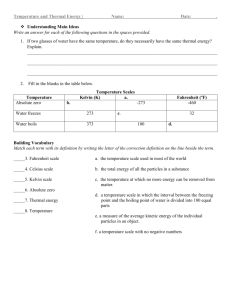
![Temperature Notes [9/22/2015]](http://s3.studylib.net/store/data/006907012_1-3fc2d93efdacd086a05519765259a482-300x300.png)

